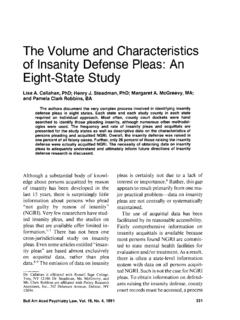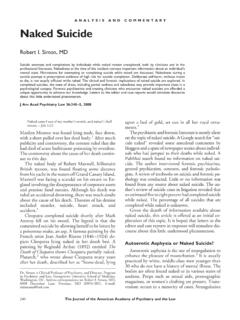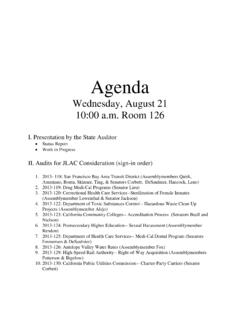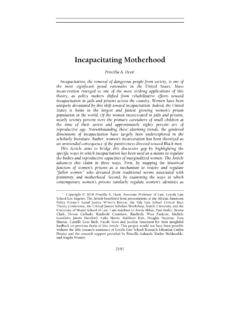Transcription of ANALYSIS AND COMMENTARY Castration of Sex Offenders ...
1 Castration of Sex Offenders : Prisoners Rights Versus Public SafetyCharles L. Scott, MD, and Trent Holmberg, MDSexual victimization of children and adults is a significant treatment and public policy problem in the United address increasing concerns regarding sex offender recidivism, nine states have passed legislation since 1996authorizing the use of either chemical or physical Castration . In most statutes, a repeat offender s eligibility forprobation or parole is linked to acceptance of mandated hormonal therapy. Future legal challenges to this waveof legislation will probably include arguments that such laws violate constitutional rights guaranteed to the offenderby the First, Eighth, and Fourteenth Amendments. When the promise of freedom is predicated on mandatedtreatment, the clinician must carefully assess the validity of informed Am Acad Psychiatry Law 31:502 9, 2003 Surgical Castration has been used as a means of socialcontrol for centuries.
2 The use of eunuchs (castratedmen) to guard women s quarters or act as chamber-lains was prevalent in many ancient cultures. Duringthe 18th century, youthful male choir members,known ascastrati, were castrated to prevent deepen-ing of their high singing voices with the onset to decrease male testosterone arenot limited to societies of the distant past. During thelate 1800s, Dr. Harry Sharp of Indiana surgicallycastrated nearly 180 male prisoners for the purpose ofreducing their sexual urges. As a result of his efforts,Indiana began using physical Castration to decreaserecidivism of certain prisoners and became the firststate to legalize the sterilization of mentaldefectives. 2 The eugenics movement of the early 20th centurycontinued the push for forced sterilization of peoplewith undesirable traits that scientists believed weregenetically transmitted.
3 This movement eventuallyled to the sterilization of approximately 60,000 men-tally handicapped incarcerated Supreme Court upheld a state law that sterilizedthe mentally infirm, Justice Oliver WendellHolmes noted, Better for all the world, if instead ofwaiting to execute degenerate offspring for crime, orto let them starve for their imbecility, society canprevent those who are manifestly unfit from continu-ing their kind..three generations of imbeciles areenough (Ref. 4, p 208). These laws, which origi-nated nearly a century ago, persist in 13 states thatcontinue to have sterilization statutes targeted at mental incompetents or the advent of modern hormonotherapy, theability to lower a man s testosterone through chemi-cal means surfaced, and the use of drugs to reducesexual recidivism has become known as chemical cas-tration.
4 The first reported use of hormonally basedmedications to reduce pathological sexual behaviorin men occurred in 1944 when the progesteronalhormonal compound diethylstilbestrol was pre-scribed to lower male the1960s, German physicians prescribed antiandrogensin an effort to curb deviant behavior of male 1966, John Money became the first to use medroxyprogesterone acetate(MPA) in the treatment of sex Offenders when headministered the drug to a bisexual transvestite whowas in therapy for pedophilic behavior with his six-year-old ,7 Although not approved by the and Drug Administration for the treatment ofsex Offenders , MPA has been used extensively in theUnited States for the purpose of diminishing sexualfantasies and decreasing sexual impulses. A similaragent, cyproterone acetate, has been used throughoutDr.
5 Scott is Chief of the Division of Psychiatry and the Law, Universityof California, Davis. He is an Assistant Professor of Clinical Holmberg is in private practice in Utah. Address correspondenceto: Charles L. Scott, MD, Department of Psychiatry, University ofCalifornia, Davis Medical Center, 2230 Stockton Blvd., Sacramento,CA 95817. E-mail: Journal of the American Academy of Psychiatry and the LawANALYSIS AND COMMENTARYC anada and recent years, other agentshave been adapted for the treatment of male sex of-fenders in an attempt to diminish their sexual offend-ing. These medications include the antiandrogensflutamide and nilutamide, the gonadotropin-releas-ing hormone analogue triptorelin, and the leuteiniz-ing hormone-releasing hormone agonists leuprolideacetate and use of such medication is understandablewhen considering the high rate of sexual victimiza-tion by Offenders against children and adults in oursociety.
6 Between 3 and 6 percent of boys and 12 and28 percent of girls in the United States are sexuallyvictimized before the age of studiesindicate that between 10 and 15 percent of womenhave been raped and nearly 25 percent of adultwomen have experienced some type of sexual magnitude of this problem combinedwith well-publicized sex crimes has increased soci-ety s awareness regarding potential dangers posed bysex Offenders . The resulting community outcry hasled to the passage of legislation requiring sex offenderregistration, mandatory community notification,civil commitment of sexually violent predators, and,more recently, Castration statutes that include bothchemical and surgical treatment options. To date,nine states have successfully passed legislation thatauthorizes either chemical or surgical Castration .
7 Asummary of these nine statutes is described in thefollowing Overview of State Castration Statutesfor Sex OffendersOn September 18, 1996, California became thefirst state to authorize the use of either chemical orphysical Castration for certain sex Offenders who werebeing released from prison into the this legislation was considered extremelycontroversial at the time, eight additional states havesubsequently passed laws that provide some form ofcastration for individuals who have been convicted ofa sex offense and are being considered for parole orprobation. Of the nine states authorizing castrationfor convicted sex Offenders , four permit the use ofchemical Castration only (Georgia, Montana, Ore-gon, and Wisconsin),12 22four allow either chemicalcastration or voluntary surgical Castration (Califor-nia, Florida, Iowa, and Louisiana),11,23 27and one(Texas)28 29provides voluntary surgical Castration asthe only treatment important similarities and differences arenoted when comparing elements among these ninestatutes.
8 First, although all statutes apply to individ-uals who have been convicted of a sex offense, all ninestates vary regarding the sexual behavior that triggersapplication of their Castration statutes. In Louisiana,for example, a conviction for any 1 of 10 specific sexoffenses renders an individual eligible for castra-tion,26 27whereas Oregon notes only that chemicalcastration will be administered to suitable offend-ers who are convicted of sex crimes. 15 18 Second,in five states, Castration is authorized only when thevictim is younger than a specified age. Two states(Louisiana26 27and Montana14) permit castrationregardless of the victim s age for repeat Offenders andtwo states (Florida23 24and Oregon15 18) allow cas-tration regardless of the victim s age, even for first-time , states differ regarding whether the pro-posed Castration is discretionary, mandatory, or vol-untary.
9 Only Louisiana26 27and Oregon15 18man-date chemical Castration for eligible first-timeoffenders. In contrast, five of the nine states mandatechemical Castration for designated repeat sex offend-ers, three allow discretion by the court in whetherchemical Castration will be required, and Texas28 29requires complete voluntary consent for surgical cas-tration under all , states are nearly equally divided in theirdesignation of who pays for the costs of castrationtreatment and subsequent monitoring. Four of thenine statutes require the state to pay costs, four re-quire the offender to bear some or the entire financialburden, and one state (Wisconsin)19 22does notspecify who pays for treatment. Finally, at least fourof the states identify consequences for treatmentnoncompliance, ranging from revocation of proba-tion (Louisiana)26 27to potential incarceration forup to 100 years (Montana).
10 14 Oregon is the onlystate that specifically includes violation of parole forthose individuals who use chemicals to counteractthe effect of chemical 18 Table 1com-pares and contrasts general elements of all nine stat-utes authorizing some form of nine statutes also vary considerably in howthey address the assessment and treatment of sex of-fenders. First, states are not uniform on what specificchemical agents are recommended for treatment. Ofthe eight statutes that authorize chemical Castration ,seven specifically identify MPA as a treatment op-Scott and Holmberg503 Volume 31, Number 4, 2003tion, and seven allow the use of other pharmaceuticalagents in addition to a medical or psychiatric evaluation is re-quired prior to Castration (either chemical or surgi-cal) represents a second important area that is treatedvery differently among these nine statutes.
















